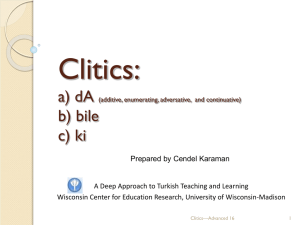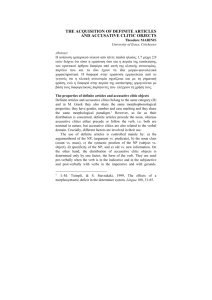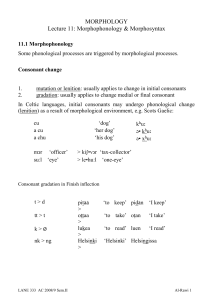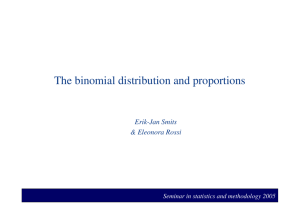Clitics and Determiners in L2 Greek
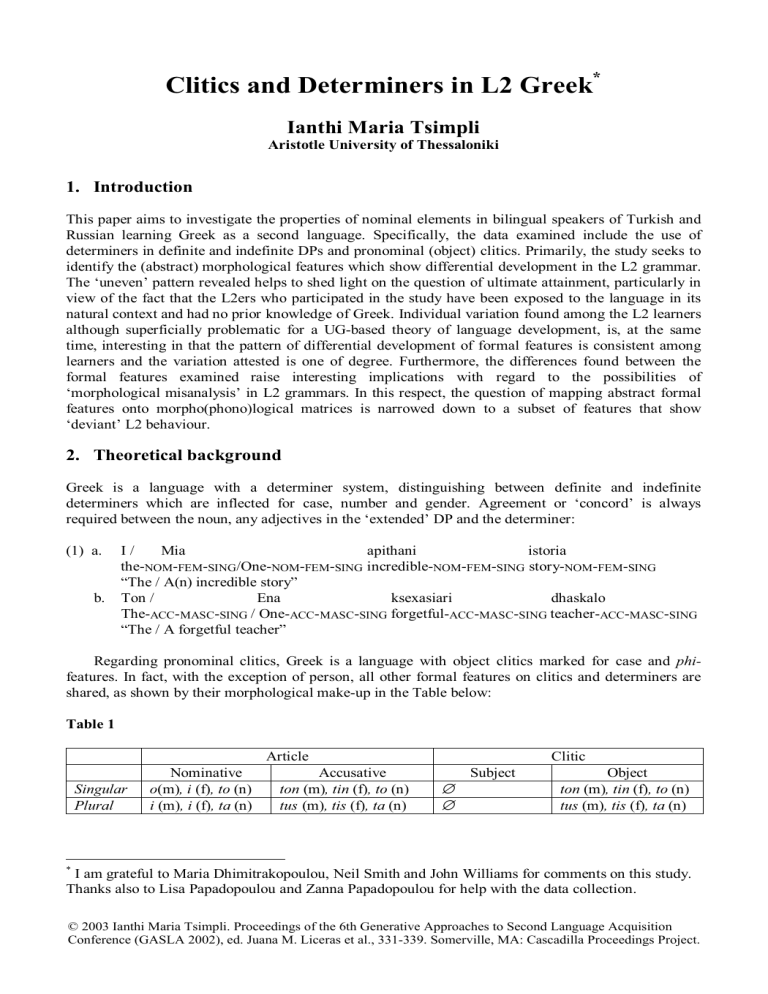
Clitics and Determiners in L2 Greek
*
Ianthi Maria Tsimpli
Aristotle University of Thessaloniki
1.
Introduction
This paper aims to investigate the properties of nominal elements in bilingual speakers of Turkish and
Russian learning Greek as a second language. Specifically, the data examined include the use of determiners in definite and indefinite DPs and pronominal (object) clitics. Primarily, the study seeks to identify the (abstract) morphological features which show differential development in the L2 grammar.
The ‘uneven’ pattern revealed helps to shed light on the question of ultimate attainment, particularly in view of the fact that the L2ers who participated in the study have been exposed to the language in its natural context and had no prior knowledge of Greek. Individual variation found among the L2 learners although superficially problematic for a UG-based theory of language development, is, at the same time, interesting in that the pattern of differential development of formal features is consistent among learners and the variation attested is one of degree. Furthermore, the differences found between the formal features examined raise interesting implications with regard to the possibilities of
‘morphological misanalysis’ in L2 grammars. In this respect, the question of mapping abstract formal features onto morpho(phono)logical matrices is narrowed down to a subset of features that show
‘deviant’ L2 behaviour.
2.
Theoretical background
Greek is a language with a determiner system, distinguishing between definite and indefinite determiners which are inflected for case, number and gender. Agreement or ‘concord’ is always required between the noun, any adjectives in the ‘extended’ DP and the determiner:
(1) a. I / Mia apithani istoria the-
NOM
-
FEM
-
SING
/One-
NOM
-
FEM
-
SING
incredible-
NOM
-
FEM
-
SING
story-
NOM
-
FEM
-
SING
“The / A(n) incredible story” b.
Ton / Ena ksexasiari dhaskalo
The-
ACC
-
MASC
-
SING
/ One-
ACC
-
MASC
-
SING forgetful-
ACC
-
MASC
-
SING teacher-
ACC
-
MASC
-
SING
“The / A forgetful teacher”
Regarding pronominal clitics, Greek is a language with object clitics marked for case and phifeatures. In fact, with the exception of person, all other formal features on clitics and determiners are shared, as shown by their morphological make-up in the Table below:
Table 1
Article
Nominative Accusative
Singular o (m) , i (f) , to (n) ton (m) , tin (f) , to (n)
Plural
∅ i (m) , i (f) , ta (n) tus (m) , tis (f) , ta (n)
∅
Subject
Clitic
Object ton (m) , tin (f) , to (n) tus (m) , tis (f) , ta (n)
*
I am grateful to Maria Dhimitrakopoulou, Neil Smith and John Williams for comments on this study.
Thanks also to Lisa Papadopoulou and Zanna Papadopoulou for help with the data collection.
© 2003 Ianthi Maria Tsimpli. Proceedings of the 6th Generative Approaches to Second Language Acquisition
Conference (GASLA 2002), ed. Juana M. Liceras et al., 331-339. Somerville, MA: Cascadilla Proceedings Project.
332
On the basis of morphological, semantic and syntactic similarities between (object) clitics and determiners it has been argued that the two elements share categorial features, i.e. they are both D elements (Sportiche 1995, Tsimpli & Stavrakaki, 1999 for Greek, cf. Marinis 2000). Tsimpli &
Stavrakaki (1999) argue further that the definite article and object clitics in Greek serve a purely grammatical function in that both lack semantic content showing expletive and resumptive uses respectively. The referentiality commonly associated with these elements is attributed to a syntactic feature-matching relation with an appropriate Def(initeness) head in the case of the article and an antecedent in the case of the clitic, respectively (cf. Cardinaletti & Starke 1994) 1 . Contrary to the definite article, the indefinite article as well as the demonstrative are assumed to belong to the D category too. However, in these cases both the indefinite and the demonstrative have inherent featurespecification for referentiality and as such they appear on a different head, namely Def (see fn.1). Thus, although both definite and indefinite articles belong to the same D system, their difference in terms of interpretability in their feature composition is crucial, as discussed below. With regard to object clitics, a similar ‘clitic-internal’ distinction is found based on the person feature. Specifically, uninterpretability of case and phi -features is associated with 3 rd person object clitics whereas 1 st and 2 nd person clitics are distinct in that the person feature in their case is interpretable (Tsimpli & Stavrakaki 1999, see also
Manzini & Savoia 1998, Torrego 1998).
With regard to the use of object clitics in matrix and embedded declaratives, note that these are always obligatory in the absence of a DP object. Thus, null objects with specific reference are ungrammatical in Greek:
(2) Speaker A: Eklises tin porta?
“Did you close the door?”
Speaker B: *(Tin)-eklisa.
Her-acc closed-1s
“I closed it.”
An explanation for the obligatory presence of a clitic in speaker B’s response can be sought in terms of the spell-out requirement of object features in Greek (case and phi -features). A similar situation is found in Romance languages as well as English, where null objects in contexts such as (2) are disallowed. It could then be argued that the lack of null objects in these languages is an effect of a licensing requirement of objects related to their formal status as D elements (Kowaluk 2001).
Regarding the morphological marking of inflection, Greek marks [+/-past] Tense distinctions and
Agreement on verbs whereas the Future and Mood are marked on modal particles (the future marker tha which can also have modal readings and the subjunctive mood marker na ):
(3) a.
Apofasisa na figho.
Decide-past-1s na leave-1s
“I decided to leave.” b.
Na efeghe!
Na leave-past-1s
“I hope/wish he would leave!” c.
Apofasisa oti tha figho.
Decide-past-1s that tha leave-1s
“I decided that I will leave.”
1
The structure of noun phrases is argued to include a DefP highest in the nominal structure where the definite article moves to in the absence of a demonstrative or indefinite article:
(i) [ DefP…[DP
[case]/[ phi -]
..[NP…]]]
It is possible that intermediate AgrPs are available in the case of adjectives along the lines suggested in Guasti
(1999). Expletive uses of the definite article found in, for example, nominalisations of adverbs, clauses etc. lack a
DefP given the absence of referentiality (Tsimpli & Stavrakaki (op.cit.)).
333
As Greek lacks infinitives, na is primarily a subordinator introducing tense-dependent clauses and does not necessarily carry semantic content of modality. In matrix clauses (3b) na has clearer semantic features of modality expressing wish, volition etc. (Philippaki-Warburton 1994). Both na and tha need to be adjacent to the verbal complex, the only elements that can appear between them are clitics and the negator mi found in [-indicative] clauses .
Assuming the distinction between interpretable and uninterpretable features at LF (Chomsky
1995), the formal features associated with clitics and the definite article are argued to be uninterpretable at this level. In particular, according to minimalist suggestions, case is an uninterpretable feature and phifeatures are interpretable on nouns. It is thus suggested that the phifeatures appearing on the definite article (as well as the adjectives) are ‘resumptive’ in that they are the spell-out of an agreement relation between the elements in the extended nominal domain which form a dependency in the syntactic derivation (Manzini, 1998). As such, they lack interpretability at LF, but they are necessary for PF convergence (Suñer 2000).
In recent proposals of language development, impairment and attrition, it has been argued that differences in interpretability play a crucial role (Sorace 2000, Bouba et al 2002, Tsimpli 2001 and (to appear)). Similar proposals have been put forward for L2 acquisition in relation to the acquisition of clitics and the uninterpretable gender feature (Tsimpli 1996, Hawkins 1998, Hawkins & Franceschina
(to appear)). Specifically, the proposal is that, of the set of parameters whose values differ between L1 and L2, uninterpretable features resist parameter-resetting and give rise to differential patterns of development compared to interpretable features which are grammaticalised in the L2 but not in the L1 or set to a different value in L1 and L2 (cf. White 1989, Bruhn de Garavito & White 2000, Schwartz &
Sprouse 1996, Vainikka & Young-Scholten 1996, a.o.). This is a weaker version of the ‘no parameterresetting’ hypothesis argued in Tsimpli & Roussou (1991) and Smith & Tsimpli (1995) and an even weaker one from ‘local impairment’ accounts (e.g. Beck 1998).
The present study is an attempt to provide further evidence for this hypothesis on the basis of L2 behaviour in Greek clitics and (definite) determiners, which, as argued above, lack interpetable features. Crucially, the hypothesis predicts an everlasting problem with these items, in that even advanced learners would not attain native-like performance in the use of D elements, compared to other aspects of L2 which involve interpretable features or uninterpetable ones which, however, also exist in the L1. In this respect, a comparison between the use of definite and indefinite articles illustrates the first case where the L2 has D elements that the L1 lacks, but only a subset of them is purely a cluster of uninterpretable features (definite vs indefinite articles). The second case is illustrated by the use of tense, agreement and modal markers which exist in L1 (Turkish and Russian), albeit not with identical spell-out properties.
2.1
Features of the L1s
Turning now to a brief outline of the properties of Turkish and Russian, the following syntactic features are shared by the two languages. First, neither Turkish nor Russian have a determiner system distinguishing between definite and indefinite articles (Kornfilt 2000, Franks & King 2000) 2 . Second, both languages allow for null objects with specific reference in contexts such as (2) above. Object deletion is, in fact, a frequent phenomenon in both Turkish and Russian. Kornfilt (2000:128) provides an example from Turkish where (4) is uttered by Speaker B in response to another person looking for his glasses:
(4) bul-du-m!
find-Past-1s
“I found (them)!”
2
Turkish marks specificity partly through case (Enç 1991, Kornfilt 1997). Slavic languages too seem to mark specificity through case in negative clauses, although this does not seem to be obligatory in all of them (Kowaluk
2001).
334
Kowaluk (2001) argues that object deletion in Slavic, like Polish and Russian, is related to the absence of a D system and its effect on the spell-out constraints on formal features found in English, Romance languages and Greek (see also Franks and King 2000 for a similar suggestion). If this is correct, then
Turkish null objects could be accounted for similarly, i.e. by virtue of the absence of a D system 3 . As far as object pronominals are concerned, note that neither language has pronominal clitics (refs. above).
With regard to the inflectional system, Tense and Agreement are morphologically marked in both languages, as they are in Greek. Mood and Modality are also marked in the two languages. In Turkish, mood/modality distinctions are marked on the verb and can appear on both matrix and embedded verb forms (Kornfilt 1997) 4 . Russian is more similar to Greek in that it has a subjunctive mood marker.
However, it is different from Greek in that this marker can either precede or follow the main verb.
Crucially, the subjunctive in Slavic languages has a modal reading and in this respect it belongs to the class of subjunctives with semantic content (cf. Progovac 1993)
3.
Predictions
On the basis of (i) the uninterpretable features of Greek clitics and (definite) determiners in section 2 above, (ii) the absence of these elements in Turkish and Russian L1s, and (iii) the hypothesis that uninterpretable features will give rise to persistent problems in advanced stages of L2 acquisition, the prediction for the bilingual learners of Greek in this study is that non-target performance, in the form of omission, will be attested in the use of these elements. On the other hand, indefinite articles, although also absent in the L1s, are predicted to be acquired and, in any case, to exhibit a different pattern of performance from that of the definite determiner.
A similar distinction is predicted to be found in the use of 1 st /2 nd as compared to 3 rd person clitics.
Again, assuming interpretability to be the distinguishing property between them, the prediction is that
L2 performance will be different, the former showing lower omission rates than the latter.
As far as inflectional features of Tense, Agreement and modality are concerned, the prediction is that they should present fewer difficulties to learners – compared to uninterpretable D elements – despite the differences in morphological properties attested between L1s and L2. Given that these features are ‘strong’ in all the languages involved, the morphological and semantic differences should not prove problematic for these learners. Thus, Tense and Agreement distinctions as well as use of modal markers in Greek L2 should be near-native and omission rates of modal markers (free morphemes) should be very low.
4.
The study
The subjects were six adult ‘early’ bilinguals in Turkish and Russian (age range: 27-46 yrs). They immigrated to Greece in the period between July 1992 and March 1993 and, at the time, had no knowledge of Greek. L2 acquisition of Greek did not involve any instruction or other form of structured input. All subjects have been working in Greek-speaking environments since the first year of their residence in the country and have been using the language on an everyday basis. The data was collected in July 2001 and comes from spoken production in the context of a forty-five minute oral interview, the first part of which consisted of questions regarding biographical details relevant to their exposure to language, length of residence, education etc.
4.1.
The data
3
Kowaluk shows that the contexts in which null objects are allowed in Slavic languages are a superset of those in
Brazilian Portuguese where null objects with specific reference are also found. Thus, object deletion is much less constrained in Slavic than in BP.
4
In Turkish, a variety of moods (optative, conditional, imperative etc) are morphologically marked, as described in
Kornfilt (1997). Almost all of them are associated with a strong semantic interpretation of modality. In this respect, the Greek na seems to have more of a grammaticalised function in the language especially in its use as a subordinator.
335
A 30-minute sample from each interview was transcribed and analysed for current purposes. In Table 2, the number of obligatory contexts for definite and indefinite DPs, and object clitics is presented:
Table 2: Total number of obligatory contexts per Category and Subject
SUBJ. No.
S1
S2
S3
S4
S5
S6
Definites
158
103
284
96
346
247
Indefinites
114
114
60
57
210
88
3rd P.Clitics
29
22
44
71
32
44
20
16
56
1st/2nd P.Clitics
63
15
5
Considering first the uses of the definite determiner in obligatory contexts shown in Figure 1, we notice that, with the exception of S5, all other subjects provided a definite determiner with a noun more frequently than they omitted it.
Figure 1
Use vs Omission of Def. Det.
100%
80%
60%
40%
20%
0%
S1 S2 S3 S4 S5 S6
Use
Omission
In Figure 2, the comparison between uses of definite and indefinite determiners is presented:
Figure 2
Uses of Def. and Indef. Ds
120%
100%
80%
60%
40%
20%
0%
S1 S2 S3 S4 S5 S6
Definites
Indefinites
The difference is significant for all subjects (p<.001). This result indicates that the prediction made with regard to the use of the definite and the indefinite determiner would show a different pattern in L2
Greek despite the categorial similarity between the two grammatical elements.
Turning now to the use of clitics, a different pattern is again found between 1 st and 2 nd person clitics on one hand, and 3 rd person clitics on the other:
336
Figure 3
Use of 1st/2nd vs 3rd p. Clitics
120%
100%
80%
60%
40%
20%
0%
S1 S2 S3 S4 S5 S6
1st / 2nd
3rd
Although the pattern is the same across subjects, in that use of 3 rd
person clitics in obligatory contexts lags behind use of 1 st
and 2 nd
person clitics, the difference is significant for all subjects (S1: Pearson’s r=15.210 p<.000
; S3: r=17.532, p<.000
; S4: r=42.576, p<.000
, S6: Fischer’s exact two-tailed p<.018
) except for S2 and S5.
In Figure 4, the comparison between omission rates of the definite determiner and the 3 rd
person clitic is presented:
F i g u re 4
O m issio n o f D e f.A rt . v s 3 rd p e rso n C li t ic s
1 00 %
9 0%
8 0%
7 0%
6 0%
5 0%
4 0%
3 0%
2 0%
1 0%
0 %
D e f.D et .
3 rd p . C l.
S 1 S 2 S 3 S 4 S 5 S 6
The difference is significant for S3 ((Pearson’s r = 5.582, p <.018) and S4 (r=28.782. p <.001) and not significant for the other subjects.
In order to test our prediction regarding the types of features that seem to cause selectively, problems for the L2 learners, verb forms were analysed for accurate use of Tense and Agreement distinctions and modal particles for two of the six subjects: S5 who shows the highest omission rate in definite determiner and 3 rd
person clitics and S6 who is lowest on omission of the definite determiner and ‘average’ in 3 rd
person clitic omission.
337
In Table 3, the uses of agreement and tense features as well as the modal particles from the data of
S6 are presented:
Table 3: Verb forms (
S6
)
Agreement Tense Modal Particles Total
1s 2s 3s 1p 2p 3p Err.
Pres Past Be Na Tha Err.
221 135 218 38 4 31 8 1% 434 209 81 156 42 4
647
Figure 5 illustrates the pattern of use of inflectional and D elements in S6’s data.
1 2 0 %
1 0 0 %
8 0 %
6 0 %
4 0 %
2 0 %
0 %
F ig u r e 5
S 6 : U se o f In fl . a n d D e le m e n t s in o b l.c o n t e x t s
Agr Tns
Mod prt Indef.D.
1st/2nd p.Cl.
Def.D.
3rd p.Cl
As shown by Figure 5, S6’s use of the definite determiner and 3 rd
person clitics are non-native-like in contrast with all other uses in the inflectional and the D domain.
The analysis of verb forms in S5’s data is presented in Table 4 and the presentation of D and Infl elements follows in Figure 6:
Table 4: Verb forms (
S5
)
Agreement
1s 2s 3s 1p 2p 3p Err.
Tense
Pr.
Past Be
Modal Particles Total
Na Tha
166 45 368 34 8 59 93 14% 397 281 117 137 6
Err.
5
680
F i g u r e 6
S5
: U s e of I n fl e c t io n a n d D e l e m e n ts i n ob l . c o n te x ts
1 2 0 %
1 0 0 %
8 0 %
6 0 %
4 0 %
2 0 %
0 %
Agr Tns
Mod.Prt.
Indef.D.
1st/2nd p.C..
Def.D.
3rd p. Cl.
338
S5 shows a similar pattern with S6 in that the use of DefD and 3rdp clitics is considerably deviant compared to inflectional categories. However, in S5’s data, 1 st and 2 nd person clitics are also low in production conforming more to the pattern of the definite determiner and 3 rd person clitics.
5.
Discussion
As shown by the data presentation in the previous section, the grammars of these learners show a differential pattern of acquisition with regard to different D elements. The definite determiner and 3 rd person clitics are omitted more frequently than the indefinite and 1 st / 2 nd person clitics respectively.
According to the hypothesis which suggests that LF-interpretability of features affects learnability, the results seem, overall to support this conclusion 5 . However, there are two open questions remaining: first an empirical one, namely the fact that in the data from S3 and S4 the difference in omission rates of the definite determiner and the 3 rd person clitic is significant. Secondly, a theoretical one, namely: why are these uninterpretable clusters of features used at all.
Starting from the theoretical question, it could possibly be argued that the use of the definite D and
3 rd person clitics is a result of learning rather than acquisition and this is a logical possibility if uninterpretable features are inaccessible to the adult L2 learner (Tsimpli & Roussou 1991, Hawkins
1998, cf. Clahsen & Muysken 1986 for a general theory of L2A based on learning strategies). The overwhelming frequency of occurrence of these elements in the input, which is also of considerable amount during the 9 years of exposure to the L2 in its natural context, makes this suggestion plausible.
There is, however, an alternative explanation for L2 development of these problematic features which, I believe, is preferable. It could be argued that L2 grammars assign interpretable features to the definite determiner and 3 rd person clitics in order to ‘acquire’ them in a UG-based fashion. Definite determiners are more easily amenable to such a ‘reanalysis’ given that interpretable features such as
[kinship] or [animacy] could become specified on these elements depending on the head noun. This alternative is to be preferred for, if correct, it helps us maintain a more restricted theory of L2 acquisition based on modular properties of language.
Going back to the empirical problem in the L2 data from S3 and S4, it could be suggested that there exist some ‘superficial’ differences in D and clitics associated with their different functions in the nominal and the verbal domain respectively. For example, Marinis (2000) argues that in early L1 data from Greek clitics and determiners, the pattern observed shows an initial period in which some nouns are introduced by definite determiners and no clitics are produced at the same time (cf. Marinis 2000).
This ‘lexical’ use of determiners may be argued to stem from the lexical acquisition of D+N as a phonological / lexical unit 6 . When the use of D becomes productive the correlation between D and clitics is attested. This ‘lexical’ acquisition of D + N could also be extended to the difference found in the L2 production of determiners and 3 rd person clitics. The latter cannot be lexically associated with the verb (except for cliches) and as such their omission rate is higher. However, this ‘difference’ does not affect the underlying categorial similarity between the definite D and 3 rd person clitics and their problematic status in the L2 grammar.
Overall then, a different pattern of development is found in the comparison between (i) definite and indefinite Ds, (ii) 1 st /2 nd and 3 rd person clitics and (iii) Inflection and D elements in the data from S5 and
S6. Given that indefinite Ds and 1 st /2 nd person clitics are missing from Turkish and Russian L1s, the native-like use of these elements in Greek L2 shows that acquisition of (clusters of) features which are not parametrically available in L1 can be acquired in L2. Moreover, the near-native like use of
Inflectional features also shows that differences in spell-out options (e.g. of Mood/Modality) can be acquired, at least in advanced L2 grammars. Thus, the relatively problematic performance in the use of the definite determiner and 3 rd person clitics cannot be attributed only to the L1s lacking these features.
5
The question why these uninterpretable clusters of features are used at all, is, of course, pending. I would like to argue that the use of the definite D and 3 rd
person clitics is a result of learning rather than acquisition and this is one possible alternative if uninterpretable features are inaccessible to the adult L2 learner. There is, however, another
6
Marinis investigates various possibilities of noun feature-specification which could be responsible for this
‘lexical’ use of determiners with specific nouns but concludes that none of them seems to work.
339
Instead, it appears that their LF-uninterpretable status is responsible for the differential pattern observed, thus providing further support to our original hypothesis.
References
Beck, M-L. 1998. L2 acquisition and obligatory head movement: English speaking learners of German and the
Local Impairment hypothesis. Second Language Research 13 (2): 93-115.
Bouba, M., F. Filiaci, C. Heycock, A. Sorace and I. Tsimpli. 2002 . Syntactic Attrition in Italian and Greek Near-
Native Speakers of English. Paper presented at the First International Conference on Language Attrition ,
Amsterdam.
Bruhn de Garavito, J. & L. White. 2000. L2 Acquisition of Spanish DPs: the Status of Grammatical Features.
BUCLD 24 Proceedings, MA: Cascadilla Press: 164-175.
Cardinaletti, A. & M. Starke. 1994. The Typology of Structural Deficiency: On the Three Grammatical Classes.
Working Papers in Linguistics, Vol. 4, No 2, Centro Linguistico Interfacolt
à
, Universita degli Studi di Venezia.
Chomsky, N. 1995. The Minimalist Program . MIT Press.
Clahsen, H. & P. Muysken. 1986. The Availability of Universal Grammar to Adult and Child Learners. A study of the Acquisition of German Word Order. Second Language Research , 2, 93-119.
Enç, M. 1991. The Semantics of Specificity.
Linguistic Inquiry 22.1:1-25.
Franks, S & T. H. King. 2000. A Handbook of Slavic Clitics. In the series Oxford Studies in Comparative Syntax .
Oxford University Press.
Hawkins, R. 1998. Explaining the Difficulty of Gender Attribution for Speakers of English. Paper presented at
EUROSLA, Paris.
Hawkins, R. & F. Franceschina (to appear). Explaining the Acquisition and Non-Acquisition of Determiner-Noun
Gender Concord in French and Spanish.
Kornfilt, J. 1997. Turkish . Routledge.
Kowaluk, A. 2001. The acquisition of Determiners and Pronouns in English L2 . Ph.D. thesis, Cambridge, UK.
Manzini, M-R. 1995. From Merge and Move to Form Dependency. UCL Working Papers in Linguistics 7: 323-
345.
Manzini, M-R. and L. Savoia. 1998. Clitics and Auxiliary Choice in Italian Dialects: Their Relevance for the
Person Ergativity Split. Recherches Linguistiques de Vincennes.
Marinis, T. 2000. The Acquisition of Clitic Objects in Modern Greek: Single Clitics, Clitic Doubling, Clitic Left
Dislocation. ZAS Working Papers 15.
Philippaki-Warburton, I. 1994. The Subjunctive Mood and the Syntactic Status of the Particle na in Modern Greek.
Folia Linguistica XXVIII/3-4: 297-328.
Philippaki-Warburton, I. 1998. Functional Categories and Modern Greek Syntax. The Linguistic Review 15: 159-
186.
Progovac, L. 1993. Locality and Subjunctive-like Complements in Serbo-Croatian. Journal of Slavic Linguistics
1:116-144.
Schwartz, B. & R. Sprouse. 1996. L2 Cognitive States and the Full Transfer/Full Access Model. Second Language
Research 12 (1):40-72.
Smith, N. & I.M.Tsimpli. 1995. The Mind of a Savant: Language Learning and Modularity.
Blackwell.
Sorace, A. (2000) Differential Effects of Attrition in the L1 Syntax of L2 Near-Native Speakers. In BUCLD
Proceedings 24, Somerville, MA: Cascadilla Press.
Sportiche, D. 1995. Clitic Constructions. In L.Zaring and J. Rooryck (eds.) Phrase Structure and the Lexicon.
Kluwer Academic Publishers, Dordrecht.
Suñer, M. 1998. Resumptive Restrictive Relatives: A Crosslinguistic Perspective. Language 74: 335-364.
Torrego, E. 1998. The Dependencies of Objects . MIT Press.
Tsimpli, I.M. & A. Roussou 1991. Parameter-Resetting in L2? In UCL Working Papers in Linguistics 3: 149-169.
Tsimpli, I. M. & S. Stavrakaki. 1999. The Effects of a Morpho-Syntactic Deficit in the Determiner System: The
Case of a Greek SLI Child. Lingua 108: 31-85.
Tsimpli, I. M. 2001. LF-Interpretability and Language Development: A Study of Verbal and Nominal Features in
Greek Normally Developing and SLI Children. Brain and Language 77: 432-448.
Vainikka, A. & M. Young-Scholten. 1996. The Early Stages in Adult L2 syntax: Additional Evidence from
Romance Speakers. Second Language Research 12 (1) : 140-176.
White, L. 1989. Universal Grammar in Second Language Acquisition. Amsterdam: John Benjamins
Proceedings of the 6th Generative
Approaches to Second Language Acquisition
Conference (GASLA 2002): L2 Links edited by Juana M. Liceras,
Helmut Zobl, and Helen Goodluck
Cascadilla Proceedings Project Somerville, MA 2003
Copyright information
Proceedings of the 6th Generative Approaches to Second Language Acquisition
Conference (GASLA 2002): L2 Links
© 2003 Cascadilla Proceedings Project, Somerville, MA. All rights reserved
ISBN 1-57473-401-6 library binding
A copyright notice for each paper is located at the bottom of the first page of the paper.
Reprints for course packs can be authorized by Cascadilla Proceedings Project.
Ordering information
Orders for the library binding edition are handled by Cascadilla Press.
To place an order, go to www.lingref.com or contact:
Cascadilla Press, P.O. Box 440355, Somerville, MA 02144, USA phone: 1-617-776-2370, fax: 1-617-776-2271, e-mail: sales@cascadilla.com
Web access and citation information
This entire proceedings can also be viewed on the web at www.lingref.com. Each paper has a unique document # which can be added to citations to facilitate access. The document # should not replace the full citation.
This paper can be cited as:
Tsimpli, Ianthi Maria. 2003. Clitics and Determiners in L2 Greek. In Proceedings of the 6th Generative
Approaches to Second Language Acquisition Conference (GASLA 2002), ed. Juana M. Liceras et al., 331-339.
Somerville, MA: Cascadilla Proceedings Project.
or:
Tsimpli, Ianthi Maria. 2003. Clitics and Determiners in L2 Greek. In Proceedings of the 6th Generative
Approaches to Second Language Acquisition Conference (GASLA 2002), ed. Juana M. Liceras et al., 331-339.
Somerville, MA: Cascadilla Proceedings Project. www.lingref.com, document #1057.
